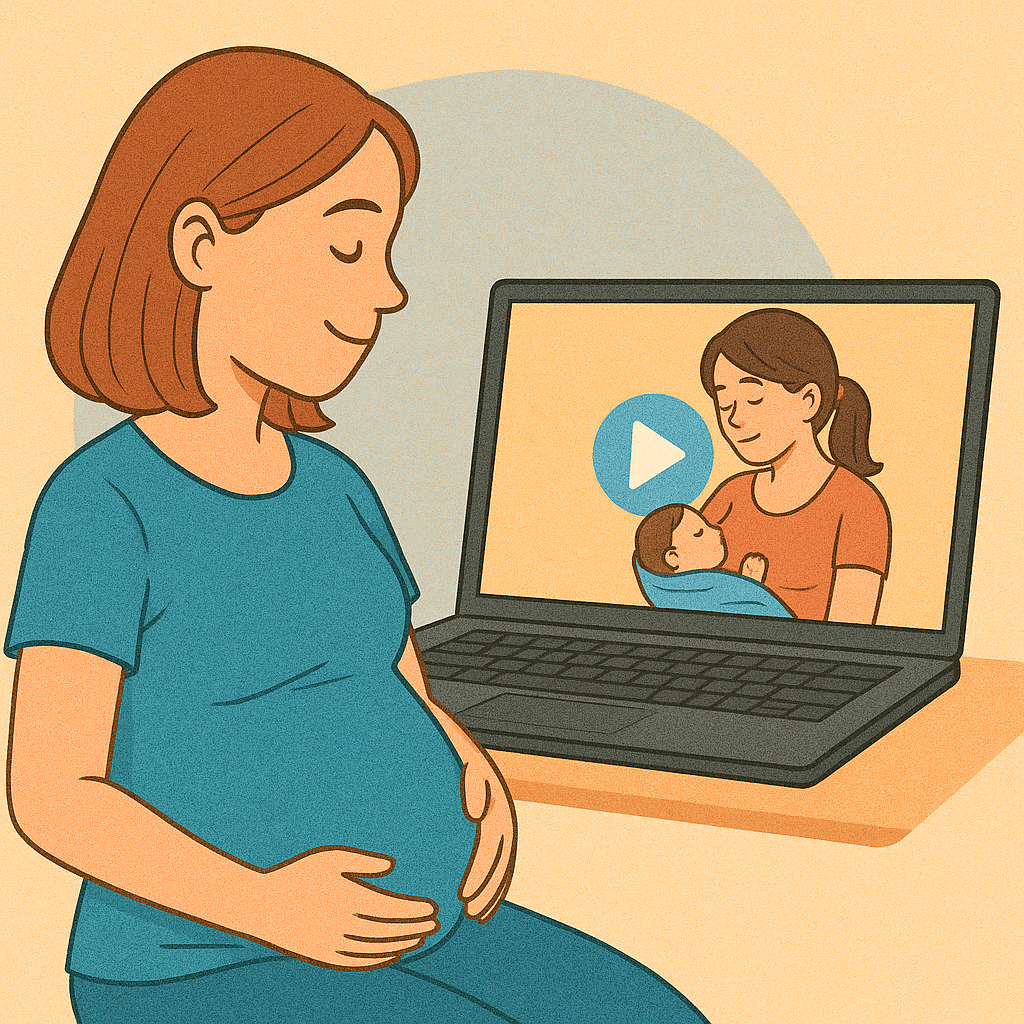ENHANCING PREGNANT WOMEN'S BREASTFEEDING SELF-EFFICACY THROUGH ANIMATED EDUCATIONAL VIDEO INTERVENTION

Downloads
Background: The prevalence of exclusive breastfeeding remains low globally, with only 44% of infants receiving it during the first six months. One contributing factor is low Breastfeeding Self-Efficacy (BSE). In Indonesia, 56% of mothers have low BSE due to inadequate education, limited family support, and psychological challenges. Animated video-based education is considered effective in increasing BSE among pregnant women, potentially enhancing exclusive breastfeeding success. This study aimed to examine the effect of breastfeeding preparation education using animation videos on BSE in third-trimester pregnant women at Tanah Kalikedinding Public Health Center, Surabaya, in 2022. Method: A quasi-experimental design with a pretest-posttest and control group was used. Seventy-four pregnant women (37 per group) were selected through consecutive sampling and met inclusion criteria: gestational age 28–36 weeks, single healthy pregnancy, ability to use WhatsApp, Google Forms, and Zoom, and willingness to participate. Exclusion criteria included serious medical conditions or hearing/vision impairments. The intervention group received an animated video titled “Manfaat ASI dan Persiapan Menyusui” (5 minutes/day for 3 days), along with Q&A and video sharing. The control group was directed to read breastfeeding material from the KIA book. Data were analyzed using Mann-Whitney and Wilcoxon tests via SPSS25. Result: Results showed a significant increase in BSE in the intervention group (mean increase = 4.97) compared to a decrease in the control group (mean decrease = 2.49), with p = 0.000. Conclusion: In conclusion, animated video-based education effectively improves breastfeeding self-efficacy and may support the success of exclusive breastfeeding programs.
Amini, P. et al. (2019) ‘The Breastfeeding Self-Efficacy Scale-Short Form (BSES-SF): a validation study in Iranian mothers’, BMC Research Notes, 12(1), p. 622. Available at: https://doi.org/10.1186/s13104-019-4656-7.
Annisa, Z., Lestari, W. and Amir, Y. (2022) ‘Hubungan Dukungan Keluarga Dengan Breastfeeding Self Efficacy (Bse) Pada Ibu Primigravida Untuk Menyusui Eksklusif’, Riau Nursing Journal, 1(1), pp. 11–19. Available at: https://doi.org/10.31258/rnj.1.1.11-19.
Asih, F.R., Pondaang, M.F. and I’anah, F.C. (2024) ‘Education with Animation Video and Flyer Improving Pregnant Women Behavior of Sleep Hygiene: Which One More Effective?’, Jurnal Kesehatan Masyarakat, 19(3), pp. 456–461.
Asimaki, E. et al. (2022) ‘Main Biopsychosocial Factors Influencing Breastfeeding: a Systematic Review.’, Maedica, 17(4), pp. 955–962. Available at: https://doi.org/10.26574/maedica.2022.17.4.955.
Awaliyah, S.N., Rachmawati, I.N. and Rahmah, H. (2019) ‘Breastfeeding self-efficacy as a dominant factor affecting maternal breastfeeding satisfaction’, BMC Nursing, 18(S1), p. 30. Available at: https://doi.org/10.1186/s12912-019-0359-6.
Ballard, O. and Morrow, A.L. (2013) ‘Human Milk Composition’, Pediatric Clinics of North America, 60(1), pp. 49–74. Available at: https://doi.org/10.1016/j.pcl.2012.10.002.
Ballesta-Castillejos, A. et al. (2020) ‘Factors that influence mothers’ prenatal decision to breastfeed in Spain’, International Breastfeeding Journal, 15(1), p. 97. Available at: https://doi.org/10.1186/s13006-020-00341-5.
Chan, M.Y., Ip, W.Y. and Choi, K.C. (2016) ‘The effect of a self-efficacy-based educational programme on maternal breast feeding self-efficacy, breast feeding duration and exclusive breast feeding rates: A longitudinal study’, Midwifery, 36, pp. 92–98.
Hamnøy, I.L. et al. (2024) ‘Breastfeeding mother’s experiences with breastfeeding counselling: a qualitative study’, International Breastfeeding Journal, 19(1), p. 34. Available at: https://doi.org/10.1186/s13006-024-00636-x.
Hasanica, N. et al. (2020) ‘The Effectiveness of Leaflets and Posters as a Health Education Method’, Materia Socio Medica, 32(2), p. 135. Available at: https://doi.org/10.5455/msm.2020.32.135-139.
He, J., Yimyam, S. and Namprom, N. (2022) ‘Breastfeeding self-efficacy, social support, and breastfeeding among Chinese mothers with late preterm infants’, Journal of Neonatal Nursing, 28(1), pp. 21–25. Available at: https://doi.org/10.1016/j.jnn.2021.07.005.
Kehinde, J., O’Donnell, C. and Grealish, A. (2023) ‘The effectiveness of prenatal breastfeeding education on breastfeeding uptake postpartum: A systematic review’, Midwifery, 118, p. 103579. Available at: https://doi.org/10.1016/j.midw.2022.103579.
Knapp, P. et al. (2022) ‘The effectiveness of video animations in the education of healthcare practitioners and student practitioners: a systematic review of trials’, Perspectives on Medical Education, 11(6), pp. 309–315. Available at: https://doi.org/10.1007/s40037-022-00736-6.
Morado Gonzales Jr, A. (2020) ‘Breastfeeding self-efficacy in Asia and Pacific: Scoping review’, Nursing Practice Today [Preprint]. Available at: https://doi.org/10.18502/npt.v8i1.4489.
Safer, W.H.Organization.D. of M.P. and Organization, W.H. (2010) Counselling for maternal and newborn health care: A handbook for building skills. World Health Organization.
Shafaei, F.S., Mirghafourvand, M. and Havizari, S. (2020) ‘The effect of prenatal counseling on breastfeeding self-efficacy and frequency of breastfeeding problems in mothers with previous unsuccessful breastfeeding: A randomized controlled clinical trial’, BMC Women’s Health, 20(1). Available at: https://doi.org/10.1186/s12905-020-00947-1.
Supeni, St., Jariyah, A. and S, H. (2022) ‘Antenatal Class Increases Knowledge and Attitude of Pregnant Women in Succeeding Early Breastfeeding Initiation’, Journal of Asian Multicultural Research for Medical and Health Science Study, 3(2), pp. 69–78. Available at: https://doi.org/10.47616/jamrmhss.v3i2.294.
Titaley, C.R. et al. (2021) ‘Determinants of low breastfeeding self-efficacy amongst mothers of children aged less than six months: results from the BADUTA study in East Java, Indonesia’, International Breastfeeding Journal, 16(1), p. 12. Available at: https://doi.org/10.1186/s13006-021-00357-5.
World Health Organization (2023) Analytical Fact Sheet. Available at: https://files.aho.afro.who.int/afahobckpcontainer/production/files/Breastfeeding_Regional_fact_sheet_2023.pdf (Accessed: 8 February 2025).
Zong, X. et al. (2021) ‘Global prevalence of WHO infant feeding practices in 57 LMICs in 2010-2018 and time trends since 2000 for 44 LMICs.’, EClinicalMedicine, 37, p. 100971. Available at: https://doi.org/10.1016/j.eclinm.2021.100971.
Copyright (c) 2025 Aan Fitri Ries Sutrisno, Desi Trianita, Fransisca Retno Asih

This work is licensed under a Creative Commons Attribution-ShareAlike 4.0 International License.
1. The journal allows the author to hold the copyright of the article without restrictions.
2. The journal allows the author(s) to retain publishing rights without restrictions
3. The formal legal aspect of journal publication accessibility refers to Creative Commons Atribution-Share Alike 4.0 (CC BY-SA).
This Journal (e-ISSN 2656-7806) is licensed under a Creative Commons Attribution-ShareAlike 4.0 International License.
















